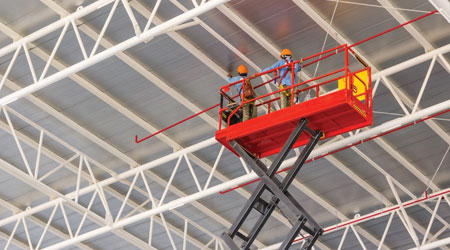 Every facility has unique specifications and requirements, which means that selecting the right MEWP for maintenance applications can often be challenging.
Every facility has unique specifications and requirements, which means that selecting the right MEWP for maintenance applications can often be challenging.Technology Advances Bring New, Exciting MEWPs Options
Standards and technology have changed, so maintenance managers should take a second look at lifts.
The technological innovations surrounding mobile elevating work platforms (MEWPs) means that maintenance managers and engineers need to stay up to speed on new industry standards. The new ANSI A92.20 standards for the aerial equipment industry have modified the design requirements for MEWPs, including boom lifts, scissor lifts and portable personnel lifts, manufactured after June 1, 2020.
These design changes, which include many new features and technologies like load sensing and tilt sensing, are intended to improve the safety of MEWPs, says Jennifer Stiansen, director of marketing with JLG.
“For load sensing, MEWPs must now be equipped with sensors that actively monitor the machine’s platform load and sound an alarm, as well as interrupt normal operations, if overloaded,” Stiansen says.
To address this requirement, built-in sensor technology in MEWPs are advanced enough to allow operators to respond to an overload situation quickly and easily. By removing or unloading items from a platform, the MEWP will recognize when it's back within its rated load capacity, enabling operations to resume without the need to recalibrate the machine.
Tilt-sensing requirements in the current standards are very similar to the load-sensing ones. The tilt sensor sounds an alarm and disables boom and drive functions if the incline surpasses the machine’s rated slope tolerance, Stiansen says. Once the machine recognizes that it’s back within its rated zone, operators are able to reposition the machine or grade the work area, to continue to complete work within the rated load and slope tolerance of the machine.
New advancements
Recent advancements in MEWP machine technology have been developed to address working on uneven terrain.
“There are new developments that contribute to operators’ productivity in space-restricted areas,” Stiansen says.
MEWPs equipped with an electronic detection system have strategically placed sensors that provide visual and audio alerts to inform the machine’s operator that they are approaching a structure. These sensors initiate the slowing down of the machine as it nears the structure, sounding an audible beep that increases in pace the closer it gets before stopping the unit completely.
“In situations where the MEWP must get closer to the structure once it is stopped, the operator can override the sensor technology to inch slowly towards the structure to place the machine nearer to the desired work area,” Stiansen says.
Technology also continues to help advance product design across the lifting equipment segment, ranging from new safety features to improved lifting capacities and to more environmentally friendly power solutions, says Matthew Elvin, CEO with Snorkel.
“We have introduced a new variable-tilt function that enables us to provide a lighter weight scissor lift that is capable of reaching the maximum working height and lifting the maximum platform capacity while outdoors,” Elvin says.
This feature allows scissor lifts to be operated on greater side-to-side slopes while the platform is below its set height. As the platform is elevated, the degree of side-to-side slope on which the machines may operate decreases accordingly.
Like many other products in facility management, lifts are embracing lithium-ion battery technology, especially for mid-size boom lifts. Unlike existing electric powered boom lifts that are commonly used only on concrete surfaces, new lithium-ion battery powered mid-size boom lifts have full four-wheel drive rough terrain capabilities, in addition to being completely zero emission.
Another recent trend is a large diversification in heights and types of lifts geared toward more specific applications, says Austin Caskey, product line manager with Sunbelt Rentals. In the past, managers would have limited options in height, weight capacity, outward reach, and basket accessory availability, now there are many more options.
“For example, facility maintenance managers and their teams used to have to rent a 19-foot scissor lift for any work being done on a standard one-story floor,” Caskey says. “Now they have many height options from 10 to 20 feet and of varying lengths and compactness so they can fit in either spacious or tight areas.”
Related Topics:











